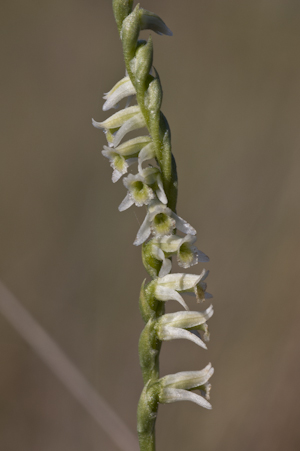Plants of South Florida · Plants by Conservation Area · Plants by County · Plants by Habitat Quick Search · Advanced Search |
||
|
|
||
 |
Spiranthes torta (Thunb.) Garay Southern lady''s-tresses |
|
|
South Florida Status: Critically imperiled. Four occurrences in three conservation areas (Big Cypress National Preserve; Everglades National Park; National Key Deer Refuge) and one non-conservation area (Luis Martinez Army Reserve Center). Taxonomy: Monocotyledon; Orchidaceae. Habit: Perennial terrestrial herb. Distribution: Native to South Florida, Bermuda, the West Indies, and Central America. South Florida Distribution: Broward, Charlotte, Collier, Miami-Dade, and Palm Beach counties, and the Monroe County Keys. South Florida Habitats: Pine rocklands, marl prairies, and flatwoods. Protection Status: Listed as endangered by FDACS and as critically imperiled by FNAI. Aids to Identification: Luer (1972) has illustrations and color photos; Chafin (2000) has illustrations and a color photo. This species is very similar to S. amesiana. It is distinguished from S. amesiana by having an oblong lip with an obtuse apex rather than an ovate lip with an acute apex and glabrous basal calli rather than basal calli with long trichomes (Wunderlin, 1998). References: Chapman, 1883; Correll, 1950; Luer, 1972; Long & Lakela, 1976; Correll & Correll, 1982; Wunderlin, 1998; Chafin, 2000; Coile, 2000; Liogier & Martorell, 2000. Synonyms: S. tortilis (Sw.) Rich.; Ibidium tortile (Sw.) House. Historical Context: John Kunkel Small and Percy Wilson first collected southern lady’s-tresses in May 1904 in pinelands between Coconut Grove and the town of Cutler in Miami-Dade County (1558, NY). Small and Wilson made two other collections in May 1904, both near the present-day entrance to Everglades National Park. Apparently, the first was between Homestead and Camp Jackson (1922, NY), and the second near Camp Longview (1706, NY). In 1930, J. Fanum collected the first plants inside of what is now Everglades National Park on Long Pine Key (s.n., US). It also has been recently reported for Everglades National Park (Reimus, 1996, 1999). Roger L. Hammer observed six plants on Long Pine Key in 1998 (personal communication, 19 February 2001). In 1915, three collections were made in pinelands near three hammocks in southern Miami-Dade County outside of what is now Everglades National Park. Small and Charles A. Mosier made the first collection near Nixon-Lewis Hammock (6402, NY), followed by Small and others near Castellow Hammock (6556, NY), and Small and others near Timms Hammock (4672, US). Pinelands around Nixon-Lewis Hammock have been completely obliterated by agricultural activities. Castellow Hammock is now part of Castellow Hammock Park, but no pineland habitat is present there today. Pinelands still surround Timms Hammock and are protected within the Miami-Dade County park, Camp Owaissa Bauer. In 1977, Donovan S. Correll and John Popenoe made a collection in a marl prairie near Goulds (48919, FTG). Bradley observed one plant there around 1995, but this station was later destroyed for a housing development. The last occurrence in Miami-Dade County to be discovered was in the Richmond Pine Rocklands. Bradley observed plants at Larry and Penny Thompson Park in 1993, but has been unable to find these plants again during subsequent visits. In 1995, Bradley found additional plants at the Luis Martinez Army Reserve Station, which is adjacent to Larry and Penny Thompson Park. Bradley first observed these plants in a marl prairie in July 1995, and made a voucher collection with Roger L. Hammer and Woodmansee that same month (52, FTG). Bradley observed around 25 plants there in 1999. This station is extant and was last observed in 2000 by Woodmansee, who saw just two plants. As with most terrestrial orchids, the number of flowering plants fluctuates each year, making it difficult to assess the size of the total population. Roy O. Woodbury and Walter M. Buswell first collected southern lady’s-tresses in the Florida Keys on Big Pine Key in 1941 (s.n., USF). This population also was vouchered by Ellsworth P. Killip several times in 1954 (44216, US; 44269, US; 44227, US) and by George N. Avery in 1964 (s.n., USF, FTG). Several stations have been collected and observed, including at least two within the present boundaries of the National Key Deer Refuge. It has been seen more recently there by Roger Hammer, who photographed a single plant in 1996 (personal communication, 19 February 2001). Several one-time collections are known, the first from near the South New River Canal just west of present-day downtown Fort Lauderdale, where John Kunkel Small made a collection in 1913 (4443, NY). O.E. Frye collected it in a drained pine slough in Charlotte County in 1946 (s.n. FLAS). It also was collected in Palm Beach County in 1968 by P.M. Cassen (406 FLAS) from a private property along Okeechobee Road west of Florida’s Turnpike. This station is about one mile south of the City of West Palm Beach Water Catchment Buffer. Finally, Chuck McCartney made a collection in the Rabenau Camp area in Collier County in 1996 (57, SEL), inside of what is now Big Cypress National Preserve. This population is presumably extant. Major Threats: Habitat destruction and degradation at Lewis Martinez Army Reserve Station; fire suppression; exotic pest plant invasions. Comments: The flowering time for this species is very brief, lasting only a couple of weeks in May or June. Recommendations: • Map and monitor known stations on a regular basis. • Designate surplus property at the Luis Martinez U.S. Army Reserve Station as a conservation area. |
||



